Felix Hieber
XRAG: Cross-lingual Retrieval-Augmented Generation
May 15, 2025Abstract:We propose XRAG, a novel benchmark designed to evaluate the generation abilities of LLMs in cross-lingual Retrieval-Augmented Generation (RAG) settings where the user language does not match the retrieval results. XRAG is constructed from recent news articles to ensure that its questions require external knowledge to be answered. It covers the real-world scenarios of monolingual and multilingual retrieval, and provides relevancy annotations for each retrieved document. Our novel dataset construction pipeline results in questions that require complex reasoning, as evidenced by the significant gap between human and LLM performance. Consequently, XRAG serves as a valuable benchmark for studying LLM reasoning abilities, even before considering the additional cross-lingual complexity. Experimental results on five LLMs uncover two previously unreported challenges in cross-lingual RAG: 1) in the monolingual retrieval setting, all evaluated models struggle with response language correctness; 2) in the multilingual retrieval setting, the main challenge lies in reasoning over retrieved information across languages rather than generation of non-English text.
Analyzing the Use of Influence Functions for Instance-Specific Data Filtering in Neural Machine Translation
Oct 24, 2022Abstract:Customer feedback can be an important signal for improving commercial machine translation systems. One solution for fixing specific translation errors is to remove the related erroneous training instances followed by re-training of the machine translation system, which we refer to as instance-specific data filtering. Influence functions (IF) have been shown to be effective in finding such relevant training examples for classification tasks such as image classification, toxic speech detection and entailment task. Given a probing instance, IF find influential training examples by measuring the similarity of the probing instance with a set of training examples in gradient space. In this work, we examine the use of influence functions for Neural Machine Translation (NMT). We propose two effective extensions to a state of the art influence function and demonstrate on the sub-problem of copied training examples that IF can be applied more generally than handcrafted regular expressions.
Sockeye 3: Fast Neural Machine Translation with PyTorch
Jul 12, 2022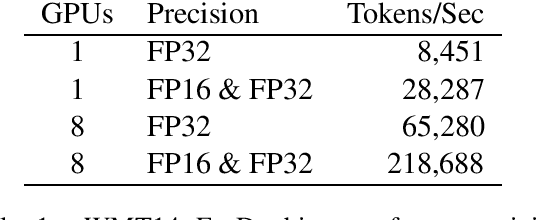
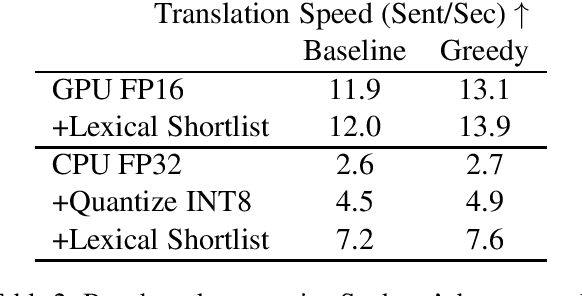


Abstract:Sockeye 3 is the latest version of the Sockeye toolkit for Neural Machine Translation (NMT). Now based on PyTorch, Sockeye 3 provides faster model implementations and more advanced features with a further streamlined codebase. This enables broader experimentation with faster iteration, efficient training of stronger and faster models, and the flexibility to move new ideas quickly from research to production. When running comparable models, Sockeye 3 is up to 126% faster than other PyTorch implementations on GPUs and up to 292% faster on CPUs. Sockeye 3 is open source software released under the Apache 2.0 license.
The Devil is in the Details: On the Pitfalls of Vocabulary Selection in Neural Machine Translation
May 13, 2022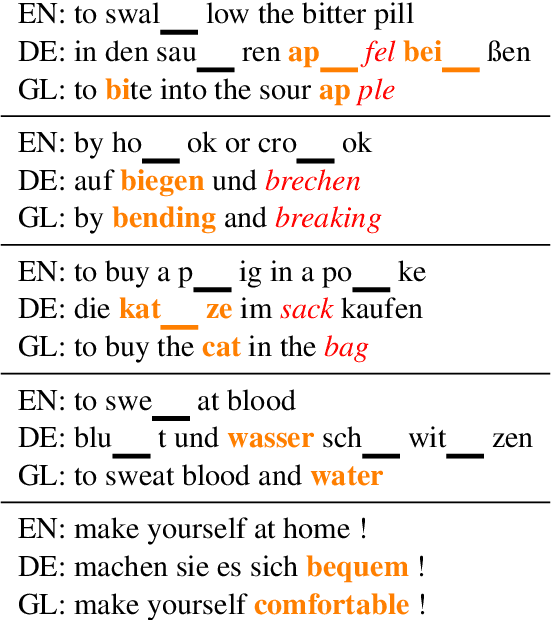



Abstract:Vocabulary selection, or lexical shortlisting, is a well-known technique to improve latency of Neural Machine Translation models by constraining the set of allowed output words during inference. The chosen set is typically determined by separately trained alignment model parameters, independent of the source-sentence context at inference time. While vocabulary selection appears competitive with respect to automatic quality metrics in prior work, we show that it can fail to select the right set of output words, particularly for semantically non-compositional linguistic phenomena such as idiomatic expressions, leading to reduced translation quality as perceived by humans. Trading off latency for quality by increasing the size of the allowed set is often not an option in real-world scenarios. We propose a model of vocabulary selection, integrated into the neural translation model, that predicts the set of allowed output words from contextualized encoder representations. This restores translation quality of an unconstrained system, as measured by human evaluations on WMT newstest2020 and idiomatic expressions, at an inference latency competitive with alignment-based selection using aggressive thresholds, thereby removing the dependency on separately trained alignment models.
The Sockeye 2 Neural Machine Translation Toolkit at AMTA 2020
Aug 11, 2020



Abstract:We present Sockeye 2, a modernized and streamlined version of the Sockeye neural machine translation (NMT) toolkit. New features include a simplified code base through the use of MXNet's Gluon API, a focus on state of the art model architectures, distributed mixed precision training, and efficient CPU decoding with 8-bit quantization. These improvements result in faster training and inference, higher automatic metric scores, and a shorter path from research to production.
Image Captioning as Neural Machine Translation Task in SOCKEYE
Oct 15, 2018



Abstract:Image captioning is an interdisciplinary research problem that stands between computer vision and natural language processing. The task is to generate a textual description of the content of an image. The typical model used for image captioning is an encoder-decoder deep network, where the encoder captures the essence of an image while the decoder is responsible for generating a sentence describing the image. Attention mechanisms can be used to automatically focus the decoder on parts of the image which are relevant to predict the next word. In this paper, we explore different decoders and attentional models popular in neural machine translation, namely attentional recurrent neural networks, self-attentional transformers, and fully-convolutional networks, which represent the current state of the art of neural machine translation. The image captioning module is available as part of SOCKEYE at https://github.com/awslabs/sockeye which tutorial can be found at https://awslabs.github.io/sockeye/image_captioning.html .
Sockeye: A Toolkit for Neural Machine Translation
Jun 01, 2018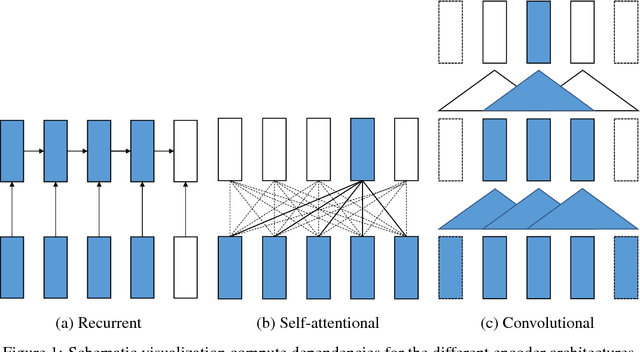
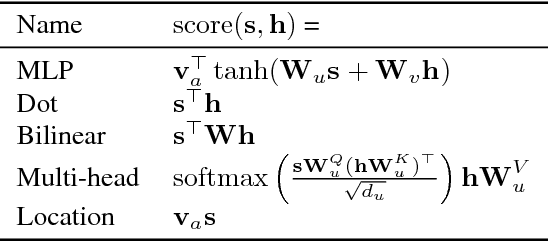

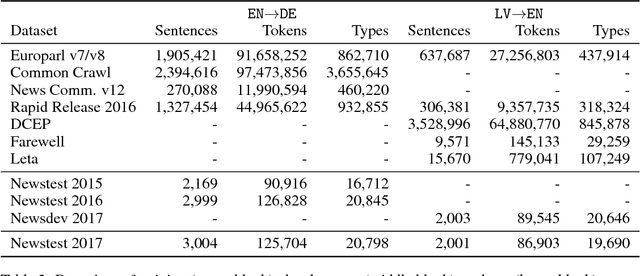
Abstract:We describe Sockeye (version 1.12), an open-source sequence-to-sequence toolkit for Neural Machine Translation (NMT). Sockeye is a production-ready framework for training and applying models as well as an experimental platform for researchers. Written in Python and built on MXNet, the toolkit offers scalable training and inference for the three most prominent encoder-decoder architectures: attentional recurrent neural networks, self-attentional transformers, and fully convolutional networks. Sockeye also supports a wide range of optimizers, normalization and regularization techniques, and inference improvements from current NMT literature. Users can easily run standard training recipes, explore different model settings, and incorporate new ideas. In this paper, we highlight Sockeye's features and benchmark it against other NMT toolkits on two language arcs from the 2017 Conference on Machine Translation (WMT): English-German and Latvian-English. We report competitive BLEU scores across all three architectures, including an overall best score for Sockeye's transformer implementation. To facilitate further comparison, we release all system outputs and training scripts used in our experiments. The Sockeye toolkit is free software released under the Apache 2.0 license.
 Add to Chrome
Add to Chrome Add to Firefox
Add to Firefox Add to Edge
Add to Edge